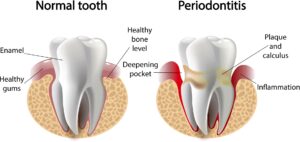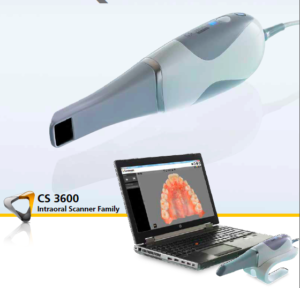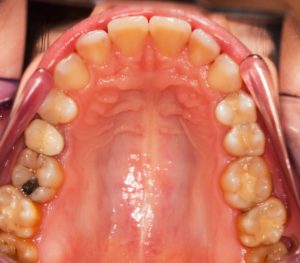Header logo
header top contact widget
Dental Fears
Nothing To Fear To Accomplish Healthy Smile Here
Posted on Apr 16, 2023 by William J. Claiborne, DDS MS
As a dental specialist, I find that many people are unfamiliar with exactly what a periodontist does. Yet, when they are recommended to see me (typically by their general dentist), it is because they need specialized care that falls under our unique set of skills.
A periodontist has advanced skills to help patients with a variety of needs that involve the gum tissues. These include:
– Treatment of all stages of gum disease (gingivitis, pregnancy gingivitis, periodontal disease, periodontitis)
– Reshaping gum tissues for esthetic enhancement (crown lengthening, gingivectomy for ‘gummy smiles’, repairing areas of gum recession)
– Diagnosis and placement of dental implants
– Treatment of lesions or cysts in oral tissues
Let’s begin with gum disease.
Because the majority of care I provide has to do with the treatment of all stages of periodontal disease, it may be helpful to understand how this develops. Although many people delay or avoid regular dental care (mistakenly thinking “if nothing hurts, then nothing must be wrong”), I have a close-up view of its destructive nature. Its formation creates cavities, periodontal (gum) disease, and leads to eventual tooth loss.
Even people who are committed to a regimen of thorough at-home oral hygiene (twice-daily brushing, daily flossing), can be doing an insufficient job of removing the daily buildup of plaque. Plaque is a sticky film of bacteria that accumulates in the mouth. When not thoroughly removed, it can harden into a mass that attaches to the base of, or in-between, teeth.
In the form of tartar, this cement-hard mass of bacteria cannot be brushed or flossed away. Once tartar forms, it can only be removed by a dentist or hygienist using special tools. Without removal, it will continue to amass and attack gum tissues, working its way beneath the gum line.
Below the gums lie the support system for natural teeth, consisting of tissues, ligaments and bone. When the bacteria reach an uncontrollable level, they become infectious. As these infectious bacteria accumulate further, symptoms of gum disease become more apparent, such as tender or swollen gums or seeing blood in the sink when brushing teeth. Breath odor may be bad on a regular basis.
As symptoms worsen, the gums become red with infectious and loosen their grip around the base of teeth. The gums may become spongy and pus pockets may form. Breath odor at this point is persistently putrid. Eventually, the structures that support teeth are compromised and teeth may loosen. Gum disease is the leading cause of adult tooth loss in the U.S.
Research has found that certain strains of oral bacteria from gum disease create reactions in the body that can trigger systemic inflammation. Thus far, research findings have shown a correlation between periodontal disease bacteria and some cancers (including pancreatic and lung), Alzheimer’s disease, pre-term babies, heart disease, stroke, diabetes, arthritis and erectile dysfunction (ED).
As if all that weren’t bad enough, one study suggests that gum disease relates to a reduction in one’s quality of life: “Periodontal disease has been linked to lower quality of life.” “Quality of life encompasses several domains, including psychological functioning and social relationships among others. Oral health-related quality of life has been shown to be reduced in patients with periodontal disease.” (https://www.hindawi.com/journals/prm/2017/5491923/)
While estimates show about 75 percent of American adults have some degree of dental fear or anxiety, over 47 percent have some level of periodontal disease. As a periodontist, both are alarming numbers. Nearly half our nation is walking around with a potentially life-threatening disease in their mouths.
Treating this may sound like it would be pretty intimidating. However, Although there are many treatments offered and at various levels, our main goal is to provide patients with comfortable and positive experiences at every visit. One way we accomplish this is through the advanced technology featured here in our Western North Carolina periodontal dental office. We feature some of the most advanced in dentistry, much of which is not available in dental offices elsewhere. Some of these features include:
LANAP With PerioLase MVP 7: Laser-Assisted New Attachment Procedure is an advanced protocol that efficiently and effectively treats advanced gum disease with the added advantages of a dental laser. This offers a non-surgical alternative for patients with moderate to severe periodontal disease. LANAP treatment leaves very little discomfort and has a quick recovery time. It has also been found to stimulate bone regrowth in damaged areas.
3D Cone Beam Imaging: Ideal for diagnoses and treatment planning, these images provide a clear view of the upper and lower jaw, used for: intricate review of endodontics; periodontics; orthodontics; implantology: TMJ; and prosthodontics, as well as dental and maxillofacial surgery. Because cone beam radiographs show sagittal, axial, and coronal planes, locating and tracking nerve canals optimizes implant placement. The process is quick, painless and at minimal levels of radiation.
CareStream Cone Beam Computer Tomography Imaging: This enhanced tomography works with 3D imaging for exceptional detail and range.
CS 3600 Intraoral Scanner: Rather than make impressions with bulky, goopy trays, this scanner quickly and comfortably captures digital impressions accurately and easily for creating precision models or appliances (crowns, inlays, onlays, bridges, orthodontic appliances and aligners, custom abutments). The scanner can also reach difficult–to–access areas in the patient’s mouth for superior results with improved patient comfort.
Computerized Dental Implant Placement: This advanced system for pre-surgical positioning of dental implants uses a 3D model of the patient’s jaw. Once the implant type is selected, a template is developed for optimal treatment success, even for complex cases.
In addition, we offer a unique environment for comfort. We understand how dental fear or anxiety can cause people to delay or avoid having dental treatment, sometimes for decades. We believe that every patient deserves respect, a gentle touch and knowing they are in a “lecture free” zone. For those who have high fear levels, we offer several sedation options, including oral and IV sedation.
Oral sedation is a pill that helps patients relax. It also has an amnesiac effect, leaving most with little or no memory of treatment afterward.
I.V. sedation (also known as ‘twilight sleep’) places the patient in a deeper sleep state and erases memory of the procedure. It is administered by a doctor of anesthesiology for optimal comfort and safety. In our Asheville office, anesthesia is overseen by a Medical Doctor (MD) who is a board certified Anesthesiologist.
With both sedation options, patients are closely monitored with advanced safety equipment throughout treatment.
I hope I’ve given you a helpful and positive picture of what a periodontist does and how he/she can help you with some challenging needs; all the while keeping you comfortable, minimizing treatment time, and shortening treatment time.
Although most of our patients are referred to us by other dentists and dental specialists, a referral is not required for accepting a new patient. Call 828-274-9440 if you feel we can make recommendations for your specific needs or provide helpful information.
Helping To Curtail Opioid Misuse
Posted on Mar 23, 2023 by William J. Claiborne, DDS MS
No one wants to be in pain. In the dental office, dentists and dental specialists see many patients enduring a great deal of pain, some of which increases in time to excruciating levels.
To resolve the pain, treating the affected area is the first step. Healing can take time and may involve a period of continued discomfort. While a dental profession wants to help patients avoid problems and pain that can arise from them, helping you get through painful periods with ease is certainly a priority.
Like others in the health care field, the field of dentistry has become rather resistant to prescribing harsh and addictive painkillers. The opioid epidemic in the U.S. is running rampant and we want to do our part in curtailing the availability of these meds.
I felt it may be helpful to share some statistics and research findings on the opioid use in America. Hopefully, this information will reassure that the dental profession is not being “stingy” with prescribing painkillers. We are trying to help control what can easily be misused or over-prescribed.
Drug overdose deaths involving prescription opioids rose from 3,442 in 1999 to 17,029 in 2017. From 2017 to 2019, the number of deaths declined to 14,139. This was followed by a slight increase in 2020, with 16,416 reported deaths. In 2021, the number of reported deaths involving prescription opioids totaled 16,706. These numbers are headed in the wrong direction, obviously.
Although physicians, dentists and others in health care have been under close scrutiny for the number of opioids prescribed, dentists are also being more diligent in limiting patient access to pain medications. Yet, there is still a concerning number who make access easier than it should be.
According to International Association for Dental Research findings shared from two studies amongst dentists and oral-maxillofacial surgeons (OMFS) (presented in March 2023), the goal is to identify high prescribers of opioids. The study, conducted at the University of Pittsburgh, used data to detect actively prescribing dentists between 2015-2019.
The study found that during this period, 2,741,030 opioids were prescribed by 199,145 dentists/OMFS. Researchers noted that over 35% of prescribers prescribed at low rates in 2015 with this percentage falling to nearly 18% in 2019. In this period, those who were “moderate” prescribers of opioids also decreased prescribing by over 82%. A slightly more active group of prescribers also decreased their number of these prescriptions.
However, 3.5% of prescribers found to be consistent in opioid prescriptions decreased in number, yet with minimal decline. For these, the rate in 2015 averaged nearly 55%. In 2019, the average was only down to 44.7%.
A particular concern in prescribing opioids is that of prescriptions submitted for children. While total opioid prescriptions have decreased in patients under 25 years of age, trends in opioid prescribing for children, adolescents, and younger adults (under 25 years of age) remains a concern.
In a study from 2013 – 2018, researchers found the opioid dispensing rate for younger patients decreased annually at a rate of approximately 15%. The largest decreases were noted for patients ages 15 to 24 years. Among children aged 0 to 5 years for whom an opioid was dispensed, the investigators observed annual increases from 2011 to 2014. For high-dosage prescriptions, these decreased from 2014 to 2018 although high-dosage, extended-release or long-acting remained at a concerning rate — nearly 28%.
Even amid an epidemic of abuse, opioid painkillers are still commonly prescribed to teenagers and young adults for conditions like tooth and back pain. Between 2005 and 2015, opioids were prescribed to teens and college-age adults at nearly 57 million visits to doctors’ offices and emergency departments.
Although more common in an ER, 15% of visits concluded with an opioid prescription with only a small decline over the 10-year study period.
A report on opioid prescription misuse by the University of Michigan shared another concern that contributes to the problem. When people get a prescription for opioid painkillers to ease pain, it is assumed that the patient has it filled right away. However, there are now findings that show some of these prescriptions are being filled more than a month later, long after acute pain should have subsided.
In 2019, 1% of opioid prescriptions from dentists and surgeons were filled more than 30 days after writing. Although the number is low, that percentage equates to more than 260,000 opioid prescriptions a year in the U.S.
This indicates to prescribing surgeons and dentists that the medications are being used for other than intended. Whether over-prescribed by the doctor or misuse by the patient, this adds to the risk factor for opioid overdose.
These delayed-fill findings have led to call for state and federal laws to better regulate the expiration periods for filling these prescriptions. Changing the systems of monitoring along these lines has been slow in coming. In 2019, 18 states allowed prescriptions for opioids and other controlled substances to be filled up to 6 months after writing with 8 states allowing dispension up to 1 year after the prescription date.
The entire team at our Asheville periodontal dental office is highly committed to providing patients with optimal comfort throughout treatment. Here, we make oral sedation available as well as I.V. sedation (“twilight sleep”). These help patients to relax fully or snooze during treatment, erasing most (or all) memory of treatment afterward.
We also want our patients to heal comfortably after periodontal treatment or dental implant placement. As a periodontist, this is helped by being respectful of gum tissues and all areas in the mouth DURING procedures. We work with each patient to help them remain comfortable during their post-procedure time. Often, this can occur without the need for heavy medications with many patients only requiring OCT pain meds.
When it comes to your treatment, our advanced imaging technology helps us to pinpoint precise areas for incisions, which helps to minimize discomfort and speed healing time. Additionally, performing treatment at an easy pace allows for minimal disruption to sensitive gum tissues.
A periodontist has advanced skills in the treatment of all stages of gum disease, the re-contouring of gum tissues, and in the placement of dental implants. This dental specialist can help provide an optimal result while helping you enjoy the highest level of comfort – during and after treatment.
Please call 828-274-9440 if you have questions about comfort, treatment, or dental fear. New patients are always welcome and a referral is not always needed.
Absorbent Gums Are On Front Line of “Hidden” Toxin Intake
Posted on Mar 15, 2023 by William J. Claiborne, DDS MS
When you hear someone mention the “gums,” the word often includes the pink, moist area inside the mouth. Not just the area inside the cheeks and under teeth, your oral tissue (“gingiva”) goes beyond what covers the upper and lower jaws and that which surrounds the base of the teeth. This includes …
• the lips
• inner lining of the lips and cheeks
• hard and soft palate
• gums that surround the base of teeth
• floor of the mouth under the tongue
• area behind wisdom teeth
• front two-thirds of the tongue
By design, these moist areas within the “oral cavity” are highly absorbent, so much so that these tissues absorb from anything put inside the mouth, including that which is quickly swallowed.
To help you understand just how important it is to maintain GOOD oral health, I thought it would be beneficial to share some of the BAD that the gum tissues endure. Because the mouth is the entry point for our bodies, you may be interested in seeing what foods and beverages contain some pretty scary ingredients.
According to the Environmental Working Group (www.ewg.org), these items include:
Nitrates and nitrites – are preservatives used in cured meats and linked to stomach cancer, esophageal cancer, and possibly brain and thyroid cancers.
Artificial sweeteners – can affect the hormones that regulate metabolism and have a negative effect on weight control.
Potassium Benzoate – A main ingredient in fireworks and rockets, this chemical preservative is found in many foods and beverages. It is commonly found in fruit juice, sparkling waters, soft drinks, jams, syrups and more.
Titanium dioxide – is a color additive used mostly in candy, which can damage DNA.
PFAS (polyfluoroalkyl “forever chemicals”) are used in food packaging and known to leach into the food itself. They increase the risk of cancer and damage the immune and reproductive systems, among many other health harms.
BVO (Brominated vegetable oil) – is used to stabilize citrus flavors in sodas and fruity drinks. It can cause neurological harm.
BHA (Butylated hydroxyanisole) – is a preservative used in cured meats and other foods. Multiple sources have identified it as a possible human carcinogen.
BHT (Butylated hydroxytoluene) – is a preservative found in cereals and other foods. This chemical cousin of BHA is a possible human carcinogen.
TBHQ (Tert-butylhydroquinone) – is a preservative used in Pop-Tarts and other processed foods. It may harm the immune system and weaken the effectiveness of vaccines.
Propyl paraben – is a preservative used in pastries and some tortillas. It causes developmental and reproductive harm.
That’s quite the long list. However, an even greater challenge to the gums comes from smoking. While everyone who smokes knows it’s “not good” for their health, it is less known the harm doesn’t come from the nicotine alone.
The American Lung Association lists the chemical culprits as:
Acetone—found in nail polish remover
Acetic acid—an ingredient in hair dye
Ammonia—a common household cleaner
Arsenic—used in rat poison
Benzene—found in rubber cement and gasoline
Butane—used in lighter fluid
Cadmium—active component in battery acid
Carbon monoxide—released in car exhaust fumes
Formaldehyde—embalming fluid
Hexamine—found in barbecue lighter fluid
Lead—used in batteries
Naphthalene—an ingredient in mothballs
Methanol—a main component in rocket fuel
Nicotine—used as an insecticide
Tar—material for paving roads
Toluene—used to manufacture paint
Puffing on E-cigs as a “safer” alternative? That doesn’t preclude your oral health from the bombardment of chemicals in the vapor. Although the Food & Drug Administration (FDA) has not begun its review of any e-cigarette or its ingredients. Unfortunately, this means they have yet to issue standards on these products or submit specific warnings of their composition and effects.
 The “e-juice” that fills the cartridges of e-cigs usually contain nicotine (which is extracted from tobacco and highly addictive), propylene glycol, flavorings and other chemicals. Studies have found that even e-cigarettes claiming to be nicotine-free contain trace amounts of nicotine. Additionally, when the e-liquid heats up, more toxic chemicals are formed.
The “e-juice” that fills the cartridges of e-cigs usually contain nicotine (which is extracted from tobacco and highly addictive), propylene glycol, flavorings and other chemicals. Studies have found that even e-cigarettes claiming to be nicotine-free contain trace amounts of nicotine. Additionally, when the e-liquid heats up, more toxic chemicals are formed.
Whether your e-cigarette contains nicotine or not, you may be surprised at the toxic toxic vapors contents below …
• Nicotine – a highly addictive substance that negatively affects adolescent brain development
• Propylene glycol – a common additive in food; also used to make things like antifreeze, paint solvent, and artificial smoke in fog machines
• Carcinogens- chemicals known to cause cancer, including acetaldehyde and formaldehyde
• Acrolein – a herbicide primarily used to kill weeds, known to cause irreversible lung damage
• Diacetyl – a chemical linked to a lung disease called bronchiolitis obliterans, or “popcorn lung”
• Diethylene glycol – a toxic chemical used in antifreeze that is linked to lung disease
• Heavy metals such as nickel, tin, lead
• Cadmium – a toxic metal found in traditional cigarettes that causes breathing problems and disease
• Benzene – a volatile organic compound (VOC) found in car exhaust
• Ultrafine particles that can be inhaled deep into the lungs
What does all this mean? As an Asheville periodontist, it shows that the gums – on the front line of intake – take the first brunt of these chemicals and toxins, often when we don’t even realize we’re providing willing intake. It also shows how important it is to keep the mouth healthy.
The periodontal dental specialty is especially attuned to how the gums are more than the pink covering in the mouth. Healthy gums are known to support your overall well-being. In addition to being consumer-aware of what your mouth encounters, it is necessary to maintain a thorough oral hygiene routine at home and an involved relationship with your general dentist.
However, if you see signs of gum disease (bleeding or sore gums, persistent bad breath, receded gums, and/or gums that are red rather than a healthy pink), it is important to see a periodontal specialist as soon as possible. Gum disease will only worsen without treatment. It can also allow infectious bacteria to enter the bloodstream, which research has linked to serious (and even deadly) health problems.
Call our Asheville periodontal dental office to schedule a consultation. If fear or anxiety has prevented you from regular dental visits, we can discuss several options (including oral or IV sedation) to provide comfortable, relaxed appointments. Our friendly staff can help you arrange this private time together by calling 828-274-9440.
Sources:
https://www.cancer.gov/publications/dictionaries/cancer-terms/def/gums
https://www.lung.org/quit-smoking/smoking-facts/whats-in-a-cigarette
https://www.ewg.org/consumer-guides/ewgs-dirty-dozen-guide-food-chemicals-top-12-avoid
Mental Health Can Adversely Affect Oral Health
Posted on Mar 06, 2023 by William J. Claiborne, DDS MS
It seems almost every week that I read findings of recent studies that correlate oral health to overall health. It is not surprising that research newly shared reveals connections of how mental health can affect oral health, and vice versa.
It shows that people with mental conditions can be a contributing factor to poor oral hygiene. These conditions include depression, mood disorders, anxiety, OCD (obsessive-compulsive disorders), mood disorders, and eating disorders. These individuals are 2.7 times more likely to experience tooth loss early.
One factor is anxiety and panic, which are often associated with dental treatment.
According to the National Institute of Mental Health, mental illnesses in the U.S. Nearly 1 in 5 adults have with a mental illness (52.9 million in 2020). These numbers have increased post-pandemic.
The Mayo Clinic shared:
“Surveys show a major increase in the number of U.S. adults who report symptoms of stress, anxiety, depression and insomnia during the pandemic, compared with surveys before the pandemic. Some people have increased their use of alcohol or drugs, thinking that can help them cope with their fears about the pandemic. In reality, using these substances can worsen anxiety and depression.”
Poor dental health can be seen in depressed people by a dentist. For example, over 46% of depressed people report tooth pain without apparent cause, known as atypical odontalgia. Too, burning mouth syndrome is an oral condition more common with adults suffering from depression.
Additionally, mental conditions have been linked to oral conditions, such as:
Gum inflammation
Periodontal disease
Cavities
Dry mouth
Chronic jaw and facial pain
Oral ulcers
The relationship between the two – oral health and mental health – seems to lie in cortisol levels. Cortisol is a stress hormone. Stress and anxiety cortisol levels that are too high adversely affect the immune system. This increases the risk of gum disease, oral sores, and infections.
Seeking professional help at the right time is essential to manage an excellent oral and mental state and overall health.
There is also a domino effect once depression or anxiety trigger an imbalance in cortisol. When one’s smile is in poor condition (cavities, stained teeth, missing teeth, bad breath), it can lead to low self-esteem and social isolation. This contributes to a lower quality of life and, in turn, disrupted mental health.
Mental health status has been shown to activate, aggravate or worsen oral problems. These include…
•Gum health and periodontitis (advanced gum disease)
When stress and periodontal disease negatively impact the body’s immune system, inflammation often worsens gum disease. Too, people who endure ongoing stress are more likely to smoke, drink alcohol, or take drugs. These can cause people to neglect maintaining good oral hygiene and be less committed to having regular dental checkups.
•Dry mouth
Eating disorders (such as anorexia nervosa and bulimia) can reduce the amount of saliva – the mouth’s bacteria-rinsing agent. A dry mouth enables the growth of bacteria. Add to this is how many antidepressant medications have a side effect of causing oral dryness.
•Pain in jaw joints
Chronic stress and anxiety are frequent contributors to facial and jaw pain. Teeth grinding and clenching are not uncommon among people with mental conditions. These actions can cause broken, worn or chipped teeth in addition to the painful conditions associated with TMJ disorders.
•Oral ulcers
Lip, tongue, and ulcers inside the mouth can occur more often in people under frequent or chronic stress.
•Developing Cavities
Individuals with mental illnesses are more likely to have dental decay due to a rise in cavity-causing bacterium with a reduced saliva flow – a recipe for developing cavities.
•Tooth erosion
Bulimia is an eating disorder in which vomiting is used to lose weight. Over a third of bulimia patients with eating disorders suffer from tooth erosion due to regurgitated stomach acids that cause tooth erosion.
•Oral cancer
When dental health neglect is coupled with heavy consumptions of alcohol and smoking, the risk of oral cancers increases. Persons who are heavy smokers and drinkers are 50 times more likely to get oral cancer compared to those who never smoke or drink heavily.
Obviously, mental health is closely connected to your oral health. Begin by speaking with a therapist or mental health specialist. Taking care of your mental health is vital to overcome related dental issues.
If you are noticing any of the signs of oral health problems, you should see a periodontal specialist as soon as possible. These signs and symptoms include:
– Bleeding gums when brushing
– Frequent bad breath
– Red, swollen gums
– Gums that are tender or sore
– Gums that pull away from the base of teeth
– Loose teeth
A periodontist is a dental specialist who can help you restore your oral health and enjoy a confident smile. If you’ve experience tooth loss, a periodontist also specializes in the placement of dental implants.
Our Asheville periodontal office also provides sedation options. These include oral and I.V. sedation (“twilight sleep”). These are administered safely by a doctor of anesthesiology who uses advanced safety equipment to monitor you throughout your procedure.
Call 828-274-9440 to schedule an exam or an initial consultation to get to know us better.
Sources include:
https://health.uconn.edu/sbirtacademy/wp-content/uploads/sites/101/2016/08/Dental-brochure.pdf
Recent Posts
Categories
Archives
- September 2024
- August 2024
- July 2024
- June 2024
- May 2024
- April 2024
- March 2024
- February 2024
- January 2024
- December 2023
- November 2023
- October 2023
- September 2023
- August 2023
- July 2023
- June 2023
- May 2023
- April 2023
- March 2023
- February 2023
- January 2023
- December 2022
- November 2022
- October 2022
- September 2022
- August 2022
- July 2022
- June 2022
- May 2022
- April 2022
- March 2022
- February 2022
- January 2022
- December 2021
- November 2021
- October 2021
- September 2021
- August 2021
- July 2021
- June 2021
- May 2021
- April 2021
- March 2021
- February 2021
- January 2021
- December 2020
- November 2020
- October 2020
- September 2020
- August 2020
- July 2020
- June 2020
- May 2020
- April 2020
- March 2020
- February 2020
- January 2020
- December 2019
- November 2019
- October 2019
- September 2019
- August 2019
- July 2019
- June 2019
- May 2019
- April 2019
- March 2019
- February 2019
- January 2019
- December 2018
- November 2018
- October 2018
- September 2018
- August 2018
- July 2018
- June 2018
- May 2018
- April 2018
- March 2018
- February 2018
- January 2018
- December 2017
- November 2017
- October 2017
- September 2017
- August 2017
- July 2017
- June 2017
- May 2017
- April 2017
- March 2017
- February 2017
- January 2017
- December 2016
- November 2016
- October 2016
- September 2016
- August 2016
- July 2016
- June 2016
- May 2016
- April 2016
- March 2016
- February 2016
- January 2016
- December 2015
- November 2015
- October 2015
- September 2015
- August 2015
- July 2015
- June 2015
- May 2015
- April 2015
- March 2015
- February 2015
- January 2015
- December 2014
- November 2014
- October 2014
- September 2014
- August 2014
- July 2014
- June 2014
- May 2014
- April 2014
- March 2014
- February 2014
- January 2014
- December 2013
- November 2013
- October 2013
- September 2013
- August 2013
- July 2013
- June 2013
- May 2013
- April 2013
- March 2013
- February 2013
- January 2013
- December 2012
- November 2012
- October 2012
- September 2012
- August 2012
- July 2012
- June 2012


